Simulation Evaluation of a Current Limiting Scheme in an Urban Rail Transit Network
Abstract
1. Introduction
2. Literature Review
3. Methods
3.1. Discrete Event Scheduling Method for Simulation Model of the Current Limiting Scheme in Different Periods
3.1.1. Description of Current Limiting Scheme
3.1.2. The Principle of Simulation Scheduling of the Current Limiting Scheme
3.2. Logic Model of Passenger Flow Control in Rail Transit Network
3.2.1. Problem Statement
3.2.2. The Establishment of an Abstract Agent Group
3.2.3. Passenger Arrival Event Control Method
3.3. Calculation of Evaluation Index of Current Limiting Scheme
3.4. Simulation Experiment
3.5. Simulation Model Inputs and Assumptions
4. Results
- (1)
- Results of the first group of unlimited current simulation experiments
- (2)
- Comparison of the simulation experimental results of the second and third groups of current limiting to visually and dynamically displaying passenger data changes at each station and train in the two groups of experiments
5. Discussion
6. Conclusions
- Using the mesoscale simulation method, the transfer process of passenger agent information data at each station of the urban rail line network replaced the details of the movement of passengers in the network, which can significantly improve the computing efficiency compared with the traditional micro-simulation model.
- The evaluation simulation model of the current limiting scheme developed in this study establishes the pros and cons of various indicators through the average value and variance of various indicators, and the delay fairness and passenger flow balance of each station and line section. The model is especially suitable for evaluating the current limiting scheme under the multi-objective planning model.
- The model can display the simulation status of the current limiting current scheme through an intuitive and vivid network passenger flow density graph and realize the visualization of station and vehicle data during the simulation process, which can accurately describe the differences in the various evaluation indicators under each passenger flow control method and can effectively assist urban rail companies to complete the evaluation and management of current limiting schemes. This has a certain significance for the simulation modeling of urban rail transit organizations.
Author Contributions
Funding
Institutional Review Board Statement
Informed Consent Statement
Data Availability Statement
Conflicts of Interest
References
- Han, B.; Yang, Z.; Yu, Y.; Qian, L.; Chen, J.; Ran, J.; Sun, Y.; Xi, Z.; Lu, F. Statistical analysis of urban rail transit operation in the world in 2020: A review. Urban Rapid Rail Transit 2021, 34, 5–11. [Google Scholar]
- Zhou, H.; Zhang, Q.; Feng, Y.; Liu, Y.; Zheng, G. Linear quadratic optimal control of passenger flow in urban rail transfer stations. In Proceedings of the International Conference on Electrical and Information Technologies for Rail Transportation, Changsha, China, 20–22 October 2017; pp. 999–1011. [Google Scholar]
- Wang, L.; Yan, X.; Zhang, Y. Coordinative passenger flow control during peak hours in urban rail stations. In Proceedings of the 15th COTA International Conference of Transportation, Beijing, China, 24–27 July 2015; pp. 1153–1164. [Google Scholar] [CrossRef]
- Li, M.; Wang, Y.H.; Jia, L.M. Passenger flow modes and control strategies in urban rail transit station. J. Southeast Univ. 2015, 1203–1208. [Google Scholar] [CrossRef]
- Ren, G.; Ouyang, Y. Coordinated passenger flow control and bus connection setting during peak hour of urban rail transit. In Proceedings of the Sixth International Conference on Transportation Engineering, Chengdu, China, 20–22 September 2019; pp. 86–94. [Google Scholar] [CrossRef]
- Xue, H.; Yang, P.; Zhang, H.; Jing, E. Modeling on coordinated passenger flow control for multiple stations in a single line of urban rail transit. IOP Conf. Ser. Earth Environ. Sci. 2018, 234, 012008. [Google Scholar] [CrossRef]
- Wang, L.; Yan, X.; Wang, Y. Modeling and optimization of collaborative passenger control in urban rail stations under mass passenger flow. Math. Probl. Eng. 2015, 2015, 1–8. [Google Scholar] [CrossRef]
- Ma, Y.; Wang, Z.; Wen, S.; Luo, Q. Modeling of flow co-control among multi-stations based on passenger equilibrium waiting for urban rail transit. J. Shenzhen Univ. Sci. Eng. 2017, 34, 441–550. [Google Scholar] [CrossRef]
- Chen, Z.; Gan, J.; Wang, X. Three-level passenger flow control model for urban rail transit in consideration of safety. J. Cent. South Univ. Sci. Technol. 2020, 51, 1441–1450. [Google Scholar]
- Zhao, P.; Yao, X.M.; Yu, D.D. Cooperative passenger inflow control of urban mass transit in peak hours. J. Tongji Univ. 2014, 42, 1340–1443. [Google Scholar]
- Yang, T.-Y.; Zhao, P.; Yao, X.-M.; Zhang, P. Coordinated optimization model of rail transit delayed train stop-skip pattern and passenger flow control. J. Transp. Syst. Eng. Inf. Technol. 2021, 21, 105. [Google Scholar]
- Li, D.-H.; Peng, Q.-Y.; Lu, G.-Y.; Wang, K.; Wu, Z.-Y. Control method for passenger inflow control with coordination on urban rail transit line in peak hours. J. Transp. Syst. Eng. Inf. Technol. 2019, 19, 141. [Google Scholar]
- Li, X.; Bai, Y.; Su, K. Collaborative passenger flow control of urban rail transit network considering balanced distribution of passengers. Mod. Phys. Lett. B 2021, 35, 2150461. [Google Scholar] [CrossRef]
- Zhang, Z.; Huang, Z. Passenger Flow Control Method for Network-Wide Operation of Urban rail Transit System: A case study in Guangzhou. IOP Conf. Ser. Earth Environ. Sci. 2021, 638, 012012. [Google Scholar] [CrossRef]
- Lu, W.; Zhang, H.; Guo, J.; Qin, Y.; Jia, L. Coordinated control of urban rail train skip-stopping and inbound passenger flow based on deep Q-network. In Proceedings of the International Conference on Electrical and Information Technologies for Rail Transportation, Qingdao, China, 21–23 October 2021; pp. 545–557. [Google Scholar]
- Chen, W.-Y.; Zhang, Y.; Chen, X.; Wang, J.-Y. Collaborative full-length and short-turning plan and joint multi-station control of passenger flow in urban rail transit. J. Transp. Syst. Eng. Inf. Technol. 2019, 19, 177. [Google Scholar]
- Zhou, W.; Hu, P.; Huang, Y.; Deng, L. Integrated optimization of bus route adjustment with passenger flow control for urban rail transit. IEEE Access 2021, 9, 63073–63093. [Google Scholar] [CrossRef]
- Lu, Y.-H.; Yang, L.-X.; Meng, F.-T.; Xia, D.-Y.; Qi, J.-G. Collaborative optimization of train timetable and passenger flow control strategy for urban rail transit. J. Transp. Syst. Eng. Inf. Technol. 2021, 21, 195. [Google Scholar]
- Wang, Y.; Yin, X. Research the simulation model of the passenger travel behavior in urban rail platform. AIP Conf. Proc. 2017, 1839, 020124. [Google Scholar] [CrossRef]
- Wang, Z.-Q. Event driven simulation model research of urban rail transit emergency treatment process. Appl. Res. Comput. 2015, 32, 125–131. [Google Scholar]
- Liu, F.; Shao, C.; Jia, H.; Dong, C. Simulation evaluation for service facilities distribution and flow lines optimization on urban rail transfer station. J. Syst. Simul. 2021, 33, 1670. [Google Scholar]
- Xu, Q.; Mao, B.; Li, M.; Feng, X. Simulation of passenger flows on urban rail transit platform based on adaptive agents. J. Transp. Syst. Eng. Inf. Technol. 2014, 14, 28–33. [Google Scholar] [CrossRef]
- Zhang, Q.; Han, B.; Li, D.; Lu, F. Evaluation method for the operation performance of urban rail transit hub based on simulation technology. Zhongguo Tiedao Kexue 2011, 32, 120–126. [Google Scholar]
- Huang, D. The Research of Urban Rail Transit Coordinated Passenger Flow Control System Using Discrete Event-Simulation-Based Optimization Method. Master’s Thesis, Southwest Jiaotong University, Chengdu, China, 2019. [Google Scholar]
- Zheng, X.; Jiang, X. The study of passenger flow control at kecun station of urban rail transit based on system dynamics. J. Rail Way Sci. Eng. 2016, 13, 2284–2289. [Google Scholar]
- Li, Y. Research on Coordination Analysis and Evaluation of Urban Rail Transit Line Operation Based on Simulation. Master’s Thesis, Beijing Jiaotong University, Beijing, China, 2015. [Google Scholar]
- Luo, Q.; Wang, Z.; Li, X.; Zhang, X.; Xiong, P. Simulation and modeling of multi-stations’ mass passenger flow control based on waiting time equalization in urban rail line. In Proceedings of the 17th Cota International Conference of Transportation Professionals, Shanghai, China, 7–9 July 2017; pp. 1813–1821. [Google Scholar] [CrossRef]
- Chen, Z. Real-Time Estimation Model and Control Method for Urban Rail Transit Line Load. Master’s Thesis, Beijing Jiaotong University, Beijing, China, 2018. [Google Scholar]
- Jiang, X.; Feng, J.; Jia, F.; Sun, J.; Li, C. Modeling and simulation of passenger flow distribution in large-scale urban rail transit network. J. China Railw. Soc. 2018, 40, 9–18. [Google Scholar]
- Liu, J.; Hu, L.; Xu, X.; Wu, J. A queuing network simulation optimization method for coordination control of passenger flow in urban rail transit stations. Neural Comput. Appl. 2021, 33, 10935–10959. [Google Scholar] [CrossRef]
- Lei, Y.; Lu, G.; Zhang, H.; He, B.; Fang, J. Optimizing total passenger waiting time in an urban rail network: A passenger flow guidance strategy based on a multi-agent simulation approach. Simul. Modell. Pract. Theor. 2022, 117, 102510. [Google Scholar] [CrossRef]
- Cong, C.; Li, X.; Yang, S.; Zhang, Q.; Lu, L.; Shi, Y. Impact estimation of unplanned urban rail disruptions on public transport passengers: A multi-agent based simulation approach. Int. J. Environ. Res. Public Health 2022, 19, 9052. [Google Scholar] [CrossRef]
- Zhang, H.; Lu, G.; Lei, Y.; Zhang, G.; Niyitanga, I. A hybrid framework for synchronized passenger and train traffic simulation in an urban rail transit network. Int. J. Rail Transp. 2022, 1–30. [Google Scholar] [CrossRef]
- Gao, L.; Jia, L. Modeling and simulation of passenger flow distribution on urban rail transit station platform. Urban Rail Transit Res. 2019, 12. [Google Scholar] [CrossRef]
- Ma, Q.; Wang, C.; Lu, J.; Ma, Y.; Zhang, W. Simulation analysis of emergency evacuation at Rail transit statio. Urban Rail Transit Res. 2016, 19, 71–74+80. [Google Scholar]
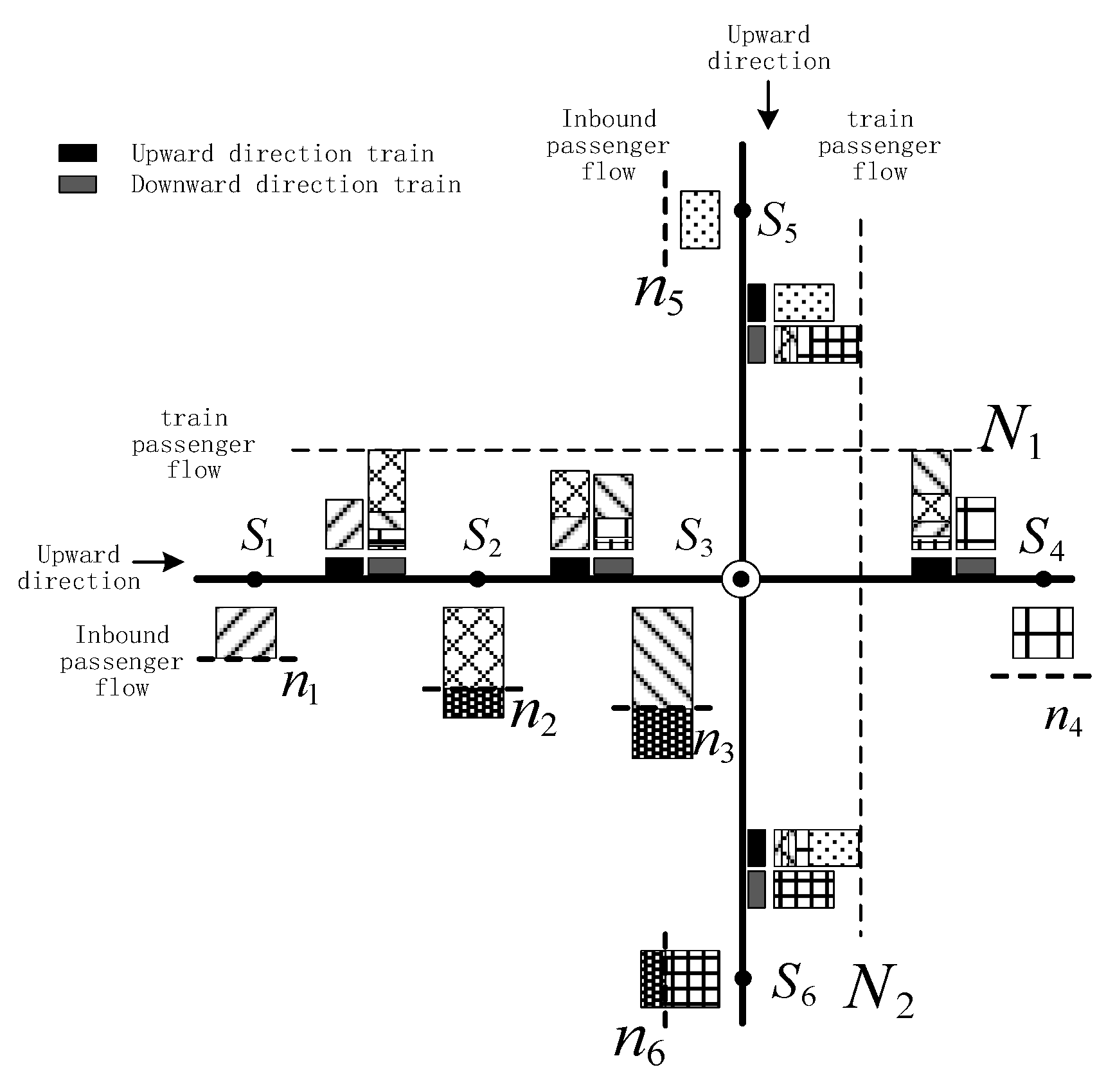

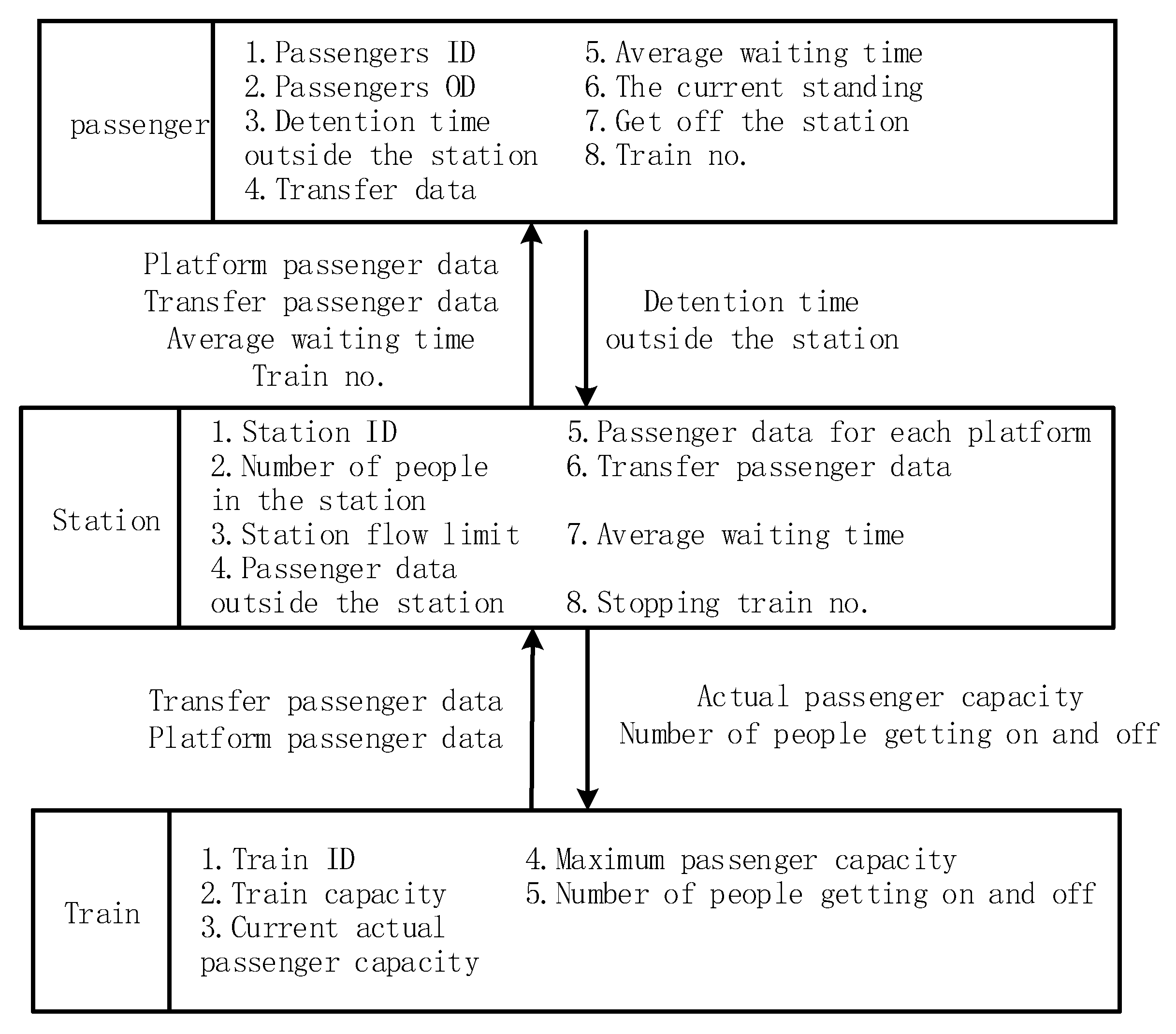

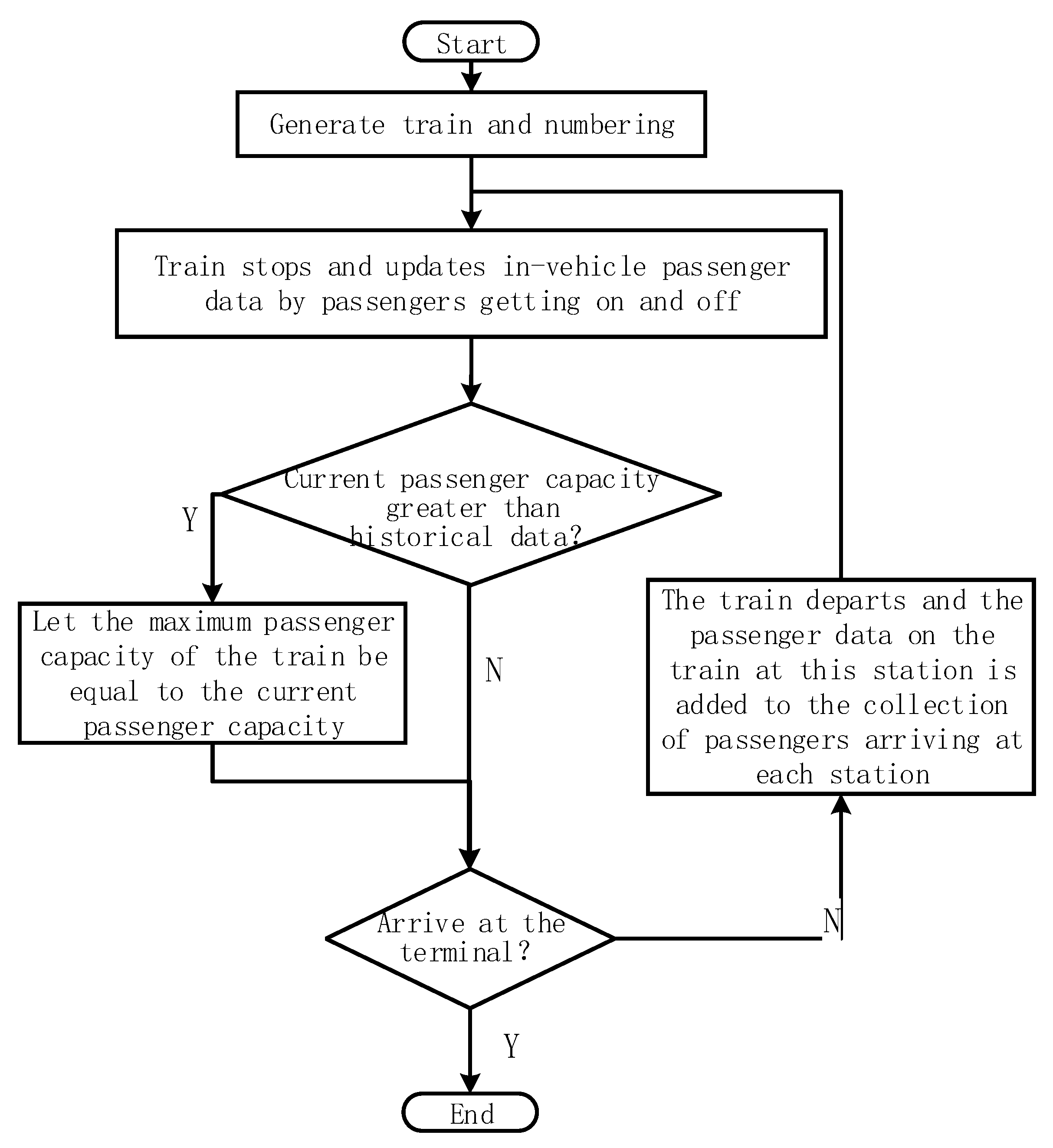
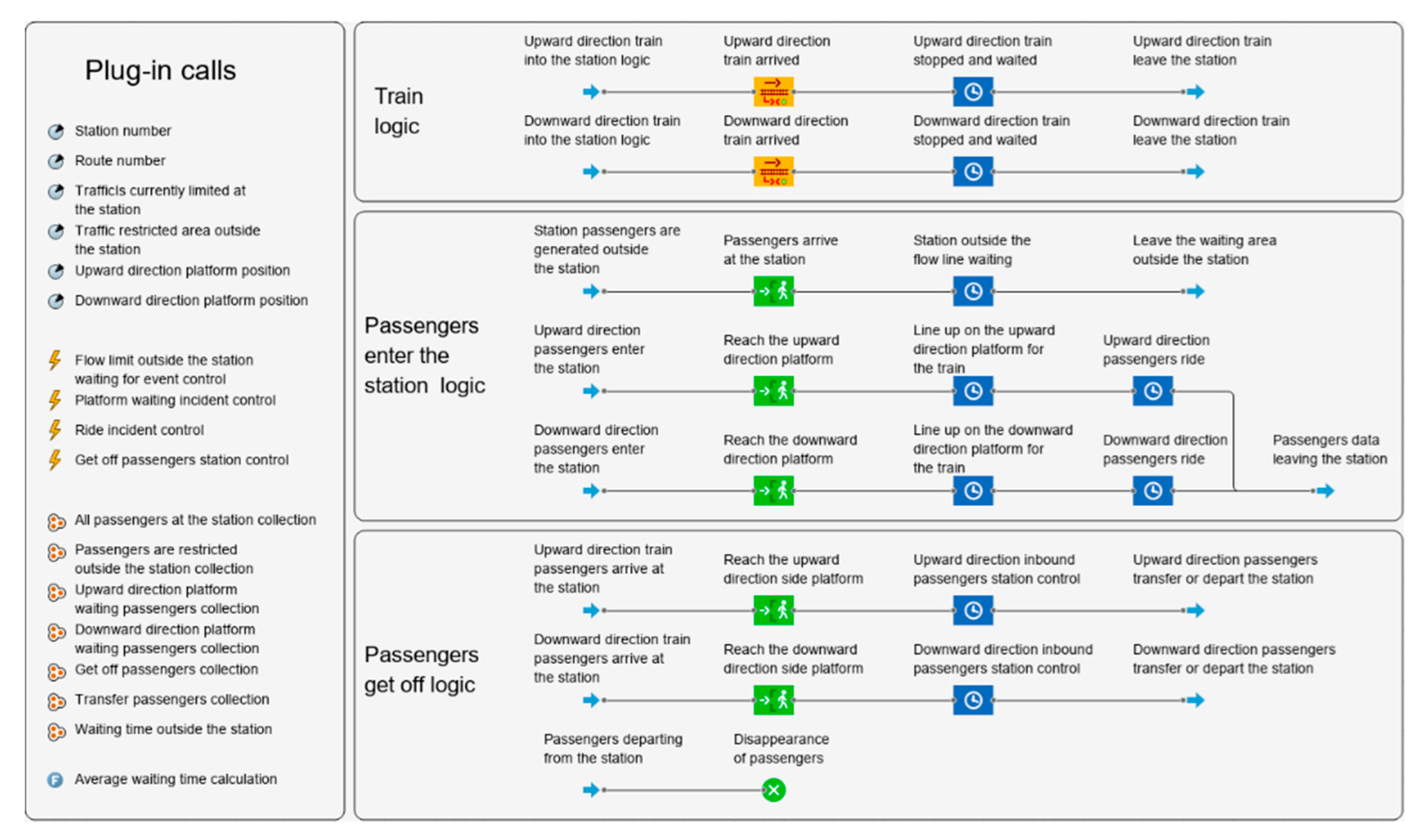
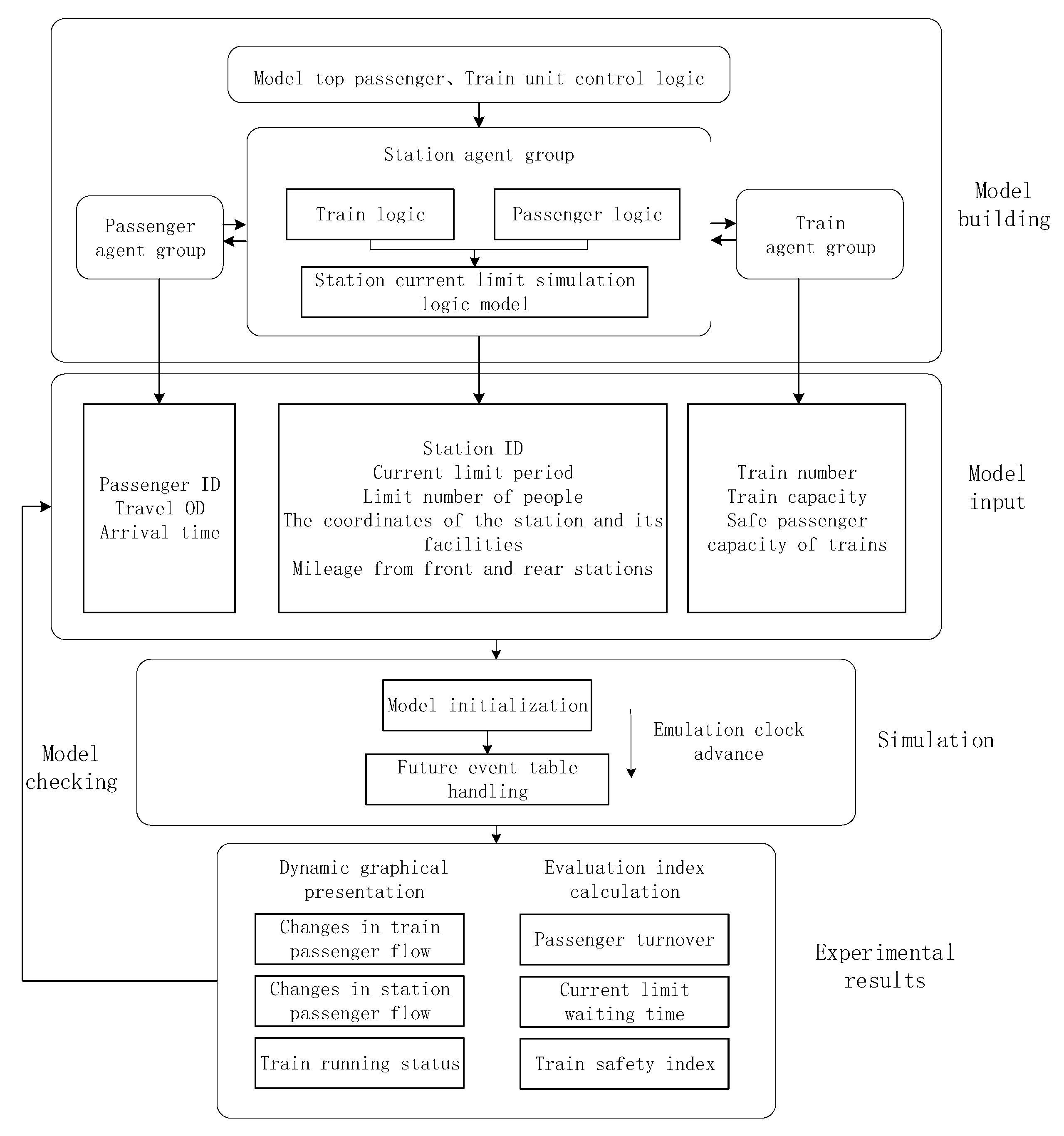

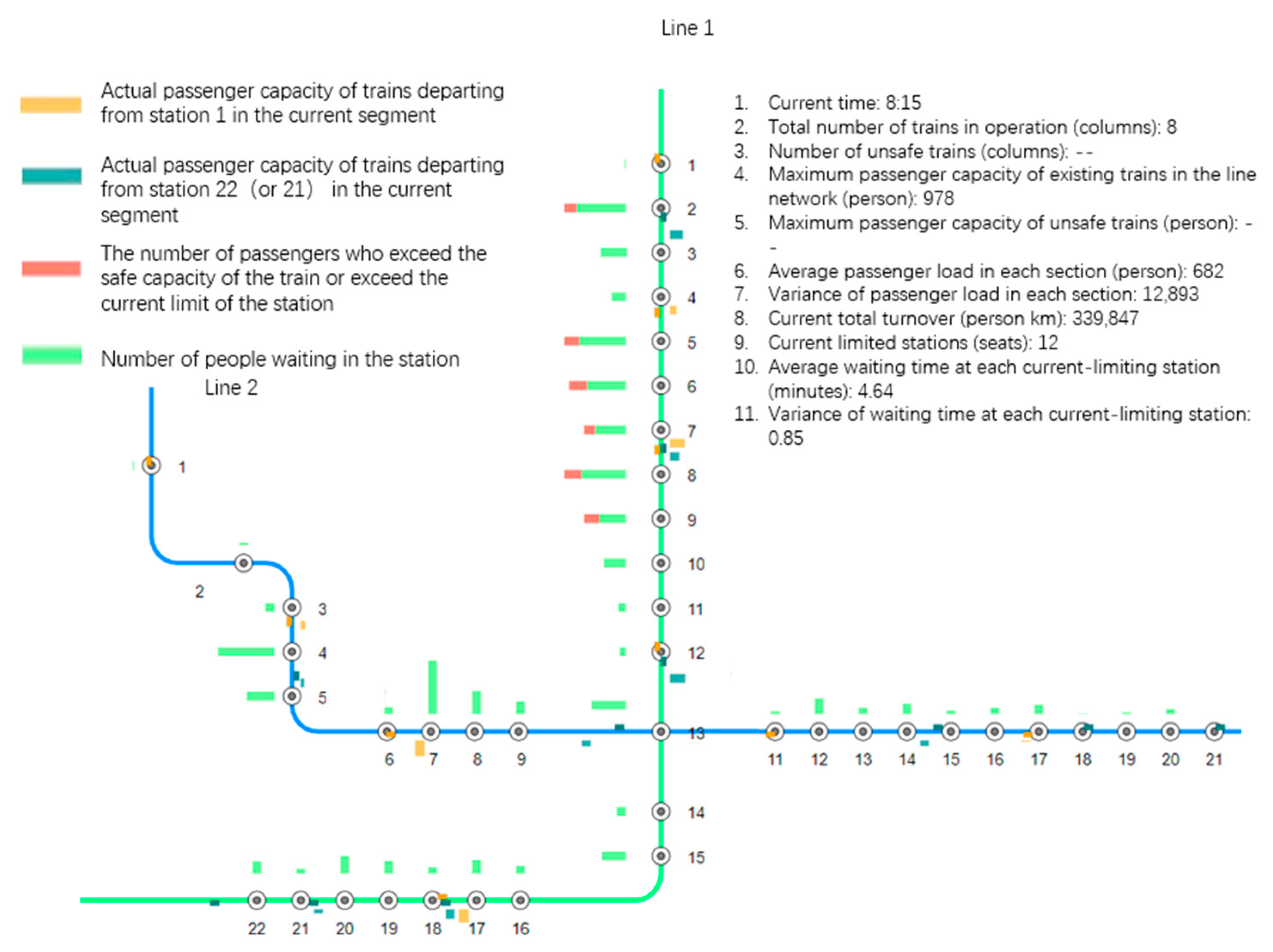
| Time | Observe the Maximum (Person) | Experimental Maximum (Person) | Deviation (Percentage) |
|---|---|---|---|
| 6:00–7:00 | 1441 | 1408 | 2.3 |
| 7:00–8:00 | 1626 | 1658 | 1.9 |
| 8:00–9:00 | 1785 | 1798 | 0.7 |
| Time | Observations (Person·km) | Experimental (Person·km) | Deviation (Percentage) |
|---|---|---|---|
| 6:00–7:00 | 135,061 | 141,130 | 4.3 |
| 7:00–8:00 | 182,671 | 176,826 | 3.2 |
| 8:00–9:00 | 192,778 | 185,261 | 3.9 |
| Evaluation Index Name | The First Set of Experimental Data | |
|---|---|---|
| Safety evaluation indicators | Total number of trains (trains) | 115 |
| Number of unsafe trains (trains) | 21 | |
| Maximum train capacity (persons) | 1658 | |
| Average maximum passenger capacity of unsafe trains (persons) | 1399 | |
| Average passenger capacity by zone (persons) | 763 | |
| Variance of passenger capacity by zone (persons) | 33,920 | |
| Effectiveness evaluation indicators | Total turnover (person km) | 503,216 |
| Time Station | 7:00– 7:15 | 7:15– 8:30 | 8:30– 9:00 |
|---|---|---|---|
| 1 | 97.00% | 95.48% | 96.27% |
| 2 | 99.68% | 91.25% | 82.87% |
| 3 | 76.45% | 84.86% | 86.96% |
| 4 | 76.78% | 54.47% | 73.48% |
| 5 | 52.33% | 51.82% | 52.16% |
| 6 | 54.30% | 53.64% | 52.77% |
| 7 | 54.58% | 56.18% | 56.59% |
| 8 | 65.47% | 50.41% | 54.24% |
| 9 | 51.22% | 53.26% | 57.47% |
| 10 | 50.68% | 74.91% | 62.14% |
| 11 | 69.74% | 72.68% | 50.00% |
| 12 | Unlimited traffic flow | 65.57% | Unlimited traffic flow |
| Evaluation Metric | Group II Experiment | Group III Experiment | |
|---|---|---|---|
| Safety evaluation indicators | Total number of trains (trains) | 115 | 115 |
| Number of unsafe trains (trains) | 9 | 0 | |
| The train has a maximum passenger capacity maximum volume (persons) | 1203 | 1013 | |
| Unsafe trains most Average large passenger capacity (persons) | 1136 | none | |
| Passenger capacity of each section average (persons) | 717 | 869 | |
| Passenger capacity of each section variance (persons) | 36,458 | 31,562 | |
| Effectiveness evaluation indicators | Total turnover (person·km) | 486,787 | 491,235 |
| Fairness indicators | Number of stations with limited flow (seats) | 7 | 11–12 |
| Average waiting time at each restricted station (minutes) | 6.69 | 5.28 | |
| Variance of waiting time at each restricted station (minutes) | 50.73 | 32.12 | |
Disclaimer/Publisher’s Note: The statements, opinions and data contained in all publications are solely those of the individual author(s) and contributor(s) and not of MDPI and/or the editor(s). MDPI and/or the editor(s) disclaim responsibility for any injury to people or property resulting from any ideas, methods, instructions or products referred to in the content. |
© 2022 by the authors. Licensee MDPI, Basel, Switzerland. This article is an open access article distributed under the terms and conditions of the Creative Commons Attribution (CC BY) license (https://creativecommons.org/licenses/by/4.0/).
Share and Cite
Hu, H.; Li, J.; Wu, S. Simulation Evaluation of a Current Limiting Scheme in an Urban Rail Transit Network. Sustainability 2023, 15, 375. https://doi.org/10.3390/su15010375
Hu H, Li J, Wu S. Simulation Evaluation of a Current Limiting Scheme in an Urban Rail Transit Network. Sustainability. 2023; 15(1):375. https://doi.org/10.3390/su15010375
Chicago/Turabian StyleHu, Hexin, Jitao Li, and Shuai Wu. 2023. "Simulation Evaluation of a Current Limiting Scheme in an Urban Rail Transit Network" Sustainability 15, no. 1: 375. https://doi.org/10.3390/su15010375
APA StyleHu, H., Li, J., & Wu, S. (2023). Simulation Evaluation of a Current Limiting Scheme in an Urban Rail Transit Network. Sustainability, 15(1), 375. https://doi.org/10.3390/su15010375






